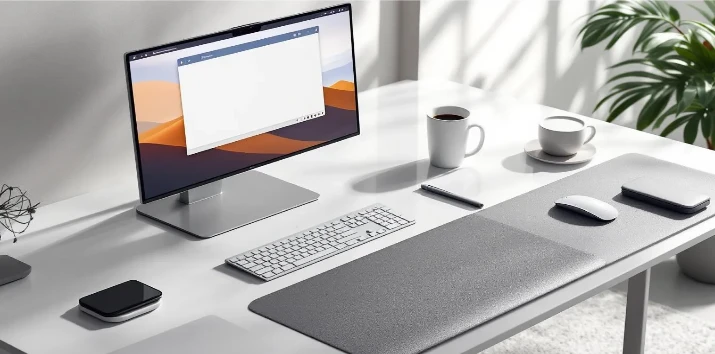Creating a Smart Home Office Setup for Remote Work Success

Remote work has become a mainstay for many professionals across various sectors. As of March 2025, about 25% of U.S. employees are working remotely, highlighting the need for a well-designed home office setup that goes beyond makeshift arrangements. A thoughtfully crafted workspace can significantly enhance productivity, focus, and work-life balance, making remote work not just feasible but enjoyable.
The shift to remote work has prompted a surge in demand for effective home office configurations. Careful consideration of individual work needs and workspace planning can create an environment that supports professional goals. This blog will guide you through practical tips to establish a functional and connected home office, ensuring your remote work success.
Understanding Your Work Needs and Daily Routine
Assessing your work needs and daily routine is crucial for an optimal home office setup. Tailoring your workspace to the specific requirements of your job enhances productivity and comfort. For example, roles involving frequent video calls benefit from improved lighting and soundproofing for clear communication and professionalism.
Different professions have distinct workspace requirements. Creative and technical roles may demand powerful devices and reliable connectivity, whereas jobs focused on administrative tasks might benefit from organizational tools like to-do lists and task management software. Tailoring your setup to accommodate these needs can create a more comfortable and efficient workspace.
Balancing work and personal life is key to a productive work environment. Clear boundaries between work hours and personal time help maintain focus and reduce burnout, supporting long-term productivity and well-being in remote work.
Understanding your daily routine helps optimize workspace efficiency. Identifying peak productivity times and arranging tasks accordingly enhances task management. Aligning your work environment with your personal rhythm, whether through a dedicated workspace or scheduled breaks, significantly improves the remote work experience.
Designing a Comfortable and Functional Workspace

Selecting the right home location is the first step in designing a comfortable, functional workspace. Important factors include:
- A quiet area with natural light to enhance concentration and reduce eye strain
- A positive, productivity-boosting atmosphere
- Adequate lighting in a distraction-free dedicated space, possibly in a separate room, to maintain focus during work hours and ensure good air quality.
Ergonomic design principles play a vital role in creating a workspace that supports long hours of focused work. Investing in ergonomic furniture, such as a comfortable ergonomic chair, a sturdy desk, a standing desk, and an office chair with lumbar support, can help maintain proper posture and reduce physical discomfort. Proper lighting, whether from natural light or desk lamps, is essential to prevent eye strain and create an inviting work environment.
Maintaining a tidy desk space is key to enhancing productivity. A disorganized desk can increase stress and reduce focus, making organizational tools essential for keeping work materials neatly stored and accessible. To stay focused, a designated relaxation area within the office also provides a space to recharge, lowering stress and preventing burnout.
Incorporating color and personal touches into your home office can positively influence your mood and motivation. Different colors can affect productivity in various ways, so choose hues that inspire and energize you. Remember, a functional home office setup is not just about physical comfort but also about creating a space that motivates and inspires you to do your best work.
Choosing the Right Connectivity Setup
Uninterrupted internet access is crucial for a successful remote work setup. A strong home broadband connection supports video conferencing, cloud-based tools, and file sharing. High-speed internet significantly impacts daily productivity and overall work experience.
Safeguarding your home network from unauthorized access and ensuring data safety involves:
- Investing in a secure router
- Using a Virtual Private Network (VPN), which encrypts your internet connection and protects sensitive data from interception
- Employing firewalls to monitor traffic and prevent unauthorized access to your network
In cases where broadband fails, having backup options like mobile data or hotspotting using an eSIM can save the day. Providers like Maxx offer handy guides and flexible eSIM options for seamless connectivity. A mesh Wi-Fi system can eliminate dead zones in your home, providing seamless internet coverage essential for remote work across multiple devices.
Whether it's:
- Wi-Fi extenders
- Ethernet cables for a more stable connection
- Network Attached Storage (NAS) for centralized file storage, choosing the right connectivity setup and cable organizers ensures a functional home office setup that supports your remote work needs.
Technology That Powers Productivity

The right tools and devices are essential for a functional home office setup that boosts productivity:
- Noise-canceling headphones block out background noise, aiding focus.
- A high-quality webcam enhances virtual meetings.
- Multiple monitors and an external monitor provide more screen real estate for multitasking.
A high-speed laptop is essential for handling multitasking and resource-heavy applications. This ensures smooth performance during video calls, project management, and other demanding tasks. Razer offers powerful laptops that are well-suited for remote professionals who need speed, reliability, and top-tier performance. Cloud-based file sharing platforms enable remote employees to access, edit, and collaborate on documents from anywhere, making them indispensable for a productive work environment.
Project management tools like Google Workspace and Microsoft Teams help remote team members stay aligned and meet deadlines. These tools offer features such as task management, communication tools, and file sharing, streamlining collaboration and keeping the remote workforce connected.
Security tools are also vital to protect sensitive information. Multi-factor authentication and encryption safeguard data, ensuring that remote employees can work securely from anywhere. By integrating various communication tools and maintaining proper ergonomics, you can create a comfortable and efficient workspace that supports your professional image and work environment.
Ongoing Maintenance and Future-Proofing Your Setup
To maintain an effective and secure remote work setup:
- Regularly update technology and systems to ensure effectiveness and security.
- Monitor remote work tools to identify issues before they impact productivity.
- Review and upgrade your internet plan as needed to maintain strong and reliable connectivity.
The flexibility offered by technologies like eSIM is particularly beneficial for those who travel or move frequently. Providers like M1 offer convenient eSIM solutions that simplify connectivity across locations without the need for physical SIM cards. Cloud-based solutions can enhance scalability and flexibility, making it easier to adapt to the evolving demands of hybrid work. Establishing a feedback loop with employees can also help organizations continuously improve their remote work environment.
A smart home office setup is not just about the latest tech but also about creating a space that supports long-term physical health, efficiency, and adaptability. Adopting a proactive approach to infrastructure management and incorporating proper ergonomics into your office setup can help you manage projects effectively and maintain better mental health.
Conclusion
Creating a smart home office setup involves understanding your work needs, designing a comfortable workspace, ensuring reliable connectivity, and investing in the right technology. Regular maintenance and future-proofing your setup are also crucial for long-term success. By following these tips, you can achieve a productive and efficient remote work environment.
Inspire yourself to continuously improve and adapt your home office to meet evolving demands. A well-thought-out workspace not only enhances productivity but also supports your overall well-being and work-life balance.
Frequently Asked Questions
Why is natural light important in a home office setup?
Natural light is essential in a home office as it enhances concentration and reduces eye strain, creating a positive atmosphere that boosts your productivity. Embrace the sunshine for a more energized workspace!
What are the benefits of using ergonomic furniture?
Using ergonomic furniture significantly enhances your comfort and productivity by supporting proper posture, reducing strain, and alleviating back pain. Invest in your well-being and experience the benefits firsthand!
How can I ensure reliable internet connectivity for remote work?
To ensure reliable internet connectivity for remote work, invest in a strong home broadband connection and a secure router, and always have backup options like mobile data or hotspotting available. Take these steps to stay connected and maximize your productivity!
What tech tools are essential for a productive remote work environment?
To maximize productivity in a remote work environment, invest in noise-canceling headphones, a high-speed laptop, multiple monitors, and effective project management and cloud-based file sharing tools. Embrace these technologies, and you'll see your efficiency soar!
How can I future-proof my home office setup?
To future-proof your home office setup, regularly update your technology and systems, review your internet plans, and incorporate cloud-based solutions. Prioritizing ergonomics will also ensure your workspace adapts to your evolving needs!



